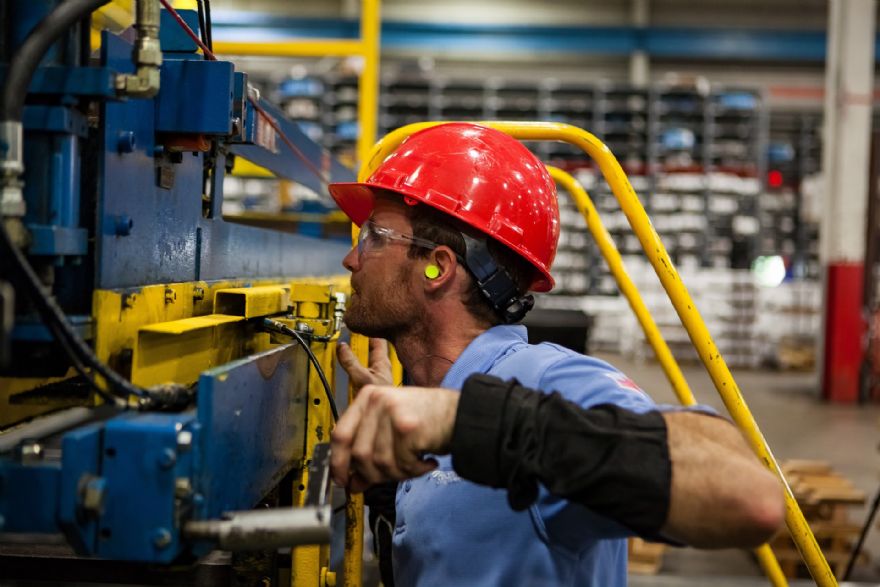
UK manufacturing output expanded for the first time in a year during October, as companies depleted backlogs of work, increased stocks and, in some cases, were boosted by a restarting of production at JLR following a recent cyber-attack.
The seasonally adjusted
S&P Global UK Manufacturing Purchasing Managers’ Index (PMI) rose to a 12-month high of 49.7 in October, up from 46.2 in September. Three of the PMI constituents (new orders, employment and stocks of purchases) registered contractions, while sub-indices for output and suppliers' delivery times were at levels consistent with improved operating conditions.
Sector data signalled that production volumes rose in the consumer and intermediate goods industries. Growth was stronger in the latter, partly reflecting a boost to some manufacturers (mainly those sensitive to the autos supply chain) from the staged restarting of production at (Jaguar Land Rover (JLR). Although investment goods output contracted for the 12th successive month, the rate of decline was the weakest during that sequence.
Market conditions faced by manufacturers remained tough, however, with demand from both domestic and overseas markets decreasing during the latest survey month. October saw total new business contract for the thirteenth month in a row, albeit to a weaker extent than in the prior month.
Export orders downAll three of the sectors covered by the survey saw new order intakes contract, with the steepest fall at investment goods producers and the slowest in the intermediate goods category. October saw the level of new export orders decline for the 45th successive month, amid reports of weaker demandfrom the USA, the EU, Asia and the Middle East. Weak global market conditions, ongoing tariff uncertainties and UK competitiveness issues were all mentioned as factors leading to reduced overseas demand.
Although business optimism climbed to an eight-month high, it remained below its long-run average. Over half of panellists expect their output to be higher one year from now, compared to 12% forecasting contraction. Positive sentiment was linked to economic recovery, efforts to regain market share,promotional activity and new product launches. In contrast, tariff uncertainty (especially the effect on overseas client confidence), domestic fiscal policy concerns, a weak global economy and heightened geopolitical tensions all weighed on UK manufacturers' sentiment.
Employment contracted for the 12th consecutive month in October, as the impact of subdued demand and earlier labour cost increases (namely higher minimum wages and employer National Insurance Contributions) continued to drive job losses. There were reports of natural attrition, hiring freezes, cost-control initiatives and difficulties finding appropriately skilled staff. That said, the overall pace of job loss eased to its weakest during the current sequence of decline, with rates decelerating across the consumer, intermediate and investment goods industries.
Although October continued to see manufacturers report operating in a high-cost environment, there were further signs that purchase price inflationary pressure is easing. Average input costs rose at the slowest pace so far in 2025, as decelerations in the consumer and intermediate goods industries offset steeper cost increases at investment goods producers.
Sharper cost increasesCompanies reported higher prices for commodities, energy, food stuffs, plastics and timber. Exchange rates, shipping issues and supply shortages were also mentioned. Small manufacturers tended to experience sharper cost increases than medium and large-scale producers. Part of the increase
in costs was passed on to customers leading to a further rise in average selling prices.
Supply chains remained stretched in October, reflecting supplier capacity issues, shipping difficulties and port disruption. This was despite a further decrease in purchasing activity among manufacturers.
Rob Dobson, a director at S&P Global Market Intelligence, said: “The October PMI survey shows UK manufacturing production rising for the first time in a year, which is a positive in itself. However, there are real concerns that the bounce could prove short-lived. Not only did October
see auto sector supply chains benefit from the production restart at JLR, which will provide only a temporary spike in production, but sluggish demand from both domestic and overseas markets meant October’s output growth was dependent on firms eating into backlogs of orders placed in prior months and allowing unsold stock to accumulate.
"There are also concerns the forthcoming Budget will exacerbate the lingering challenges created by last year’s Budget, especially in relation the impact of National Minimum Wage and employer National Insurance Contributions on costs, demand and production. This means that business optimism remains below its long-run average despite rising to an eight-month high in October. Manufacturers seem to be stuck in a holding pattern until the domestic policy and geopolitical backdrops exhibit greater clarity.”
Exceptional circumstancesRichard Powell, a partner at MHA, said: The rise in the manufacturing PMI figure is no surprise given the exceptional circumstances of the JLR closure and then the restart. While welcome news that the pace of decline has slowed, at below 50, the data suggests a sector still in contraction and does little to alter the malaise that currently hangs over the sector at present. Manufacturing is in a ‘wait and see’, if not ‘wait and anxiously hope’ mode.
“Certainly, our clients are telling us that corporate activity and investment is almost at a standstill barring a few transactions being brought forward to complete by 26 November to avoid the implications of potential tax changes that might be introduced in the Budget.
“It is hard not to overestimate the importance of the next Budget to the sector. The industry, long considered the backbone of the British economy, finds itself at a critical juncture, from rising costs, global competition, to policy uncertainty. This is a vital opportunity for the government to demonstrate its commitment to revitalising UK manufacturing.
“The sector is not asking for handouts, they are asking for clarity, consistency, and commitment. The Chancellor must deliver a framework that enables long-term planning, supports innovation, and restores confidence in the UK as a manufacturing powerhouse. Anything less risks leaving the industry further adrift at a time when global competitors are surging ahead.”